Key takeaways:
- Every student is unique; tailoring behavior management strategies to individual needs enhances engagement and classroom dynamics.
- Clear expectations and student involvement in rule-making foster responsibility and commitment to classroom norms.
- Positive reinforcement, such as reward systems and verbal praise, significantly boosts student motivation and participation.
- Consistent consequences and transparent communication about disciplinary measures create a fair and safe learning environment.
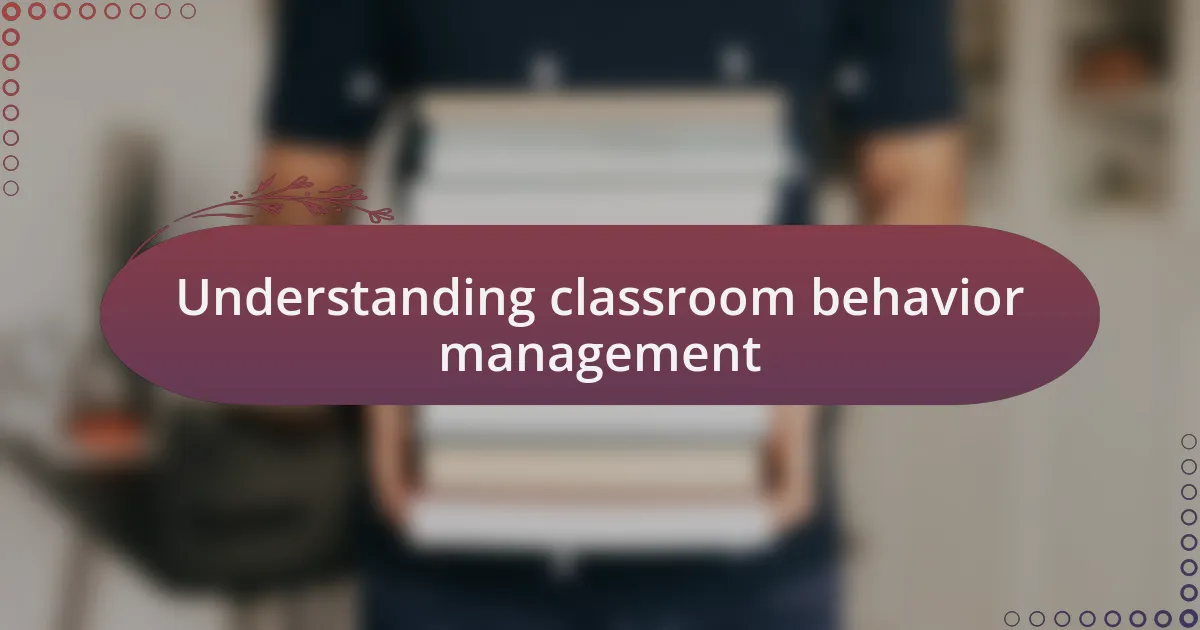
Understanding classroom behavior management
Understanding classroom behavior management requires recognizing that every student is unique. I’ve often found that what works for one child may not resonate with another. For instance, I once had a student who thrived with verbal praise, while another responded better to quiet, one-on-one discussions. How do we navigate these differences, and what strategies can we implement for each individual?
Moreover, effective behavior management hinges on clear expectations. I remember setting up a ‘classroom contract’ with my students, where we collectively agreed on rules and consequences. It empowered them and fostered a sense of ownership. In my experience, when students contribute to creating these guidelines, they tend to take them more seriously. How can we involve our students even further in this process to enhance their commitment?
Lastly, building relationships is fundamental. A teacher once shared with me that taking a few moments each day to connect with each student made a remarkable difference in their behavior. I adopted this approach and noticed a significant shift in classroom dynamics. What if we all made time for those personal connections? Imagine the impact on classroom behavior when students feel valued and understood.
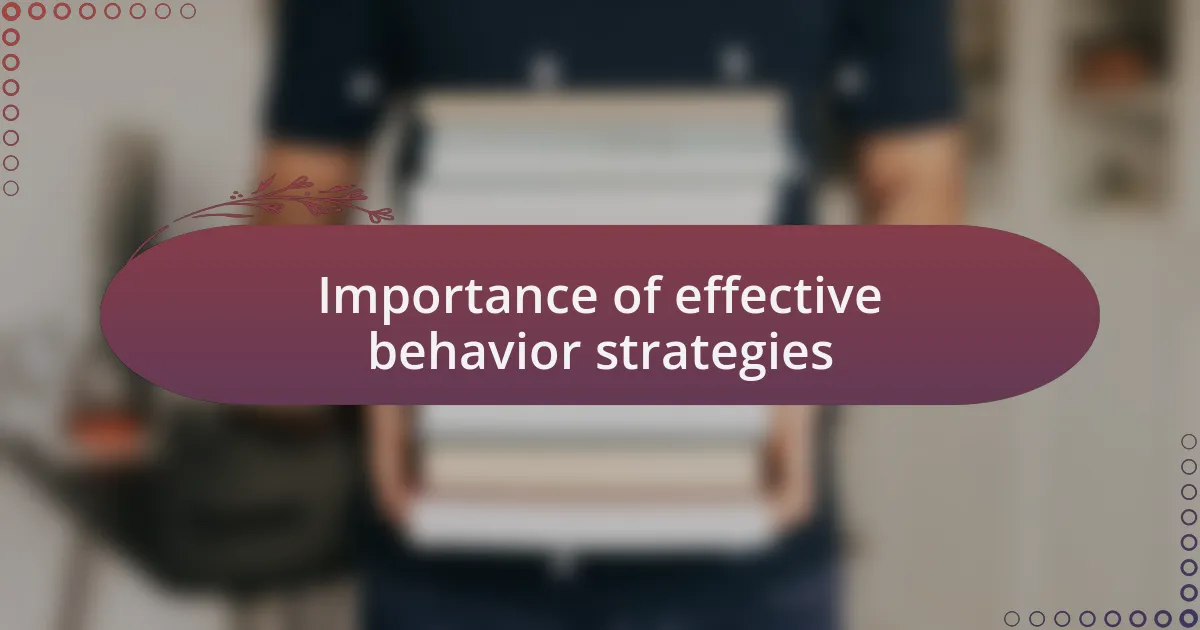
Importance of effective behavior strategies
Effective behavior strategies play a vital role in creating a positive learning environment. I remember a time when I implemented a reward system where students could earn points for positive behavior. It was eye-opening to see how motivated they became; the classroom buzzed with enthusiasm and cooperation. How can we harness that intrinsic motivation in our strategies to foster even more engagement?
Moreover, these strategies help establish a culture of respect and responsibility among students. When I encouraged my class to hold each other accountable through peer feedback sessions, the results were astonishing. Students not only learned to communicate their thoughts constructively, but they also began to recognize the importance of their actions in a community setting. Isn’t it fascinating how empowering students in their own behavior can lead to a more harmonious classroom?
Additionally, exploring effective behavior strategies can significantly reduce disruptive incidents, allowing for more uninterrupted learning time. In one instance, after incorporating conflict resolution techniques, I observed a noticeable decrease in disagreements among students during group activities. The idea that they could peacefully solve their differences changed the atmosphere entirely. Shouldn’t every educator strive to create that kind of harmony in their classrooms?
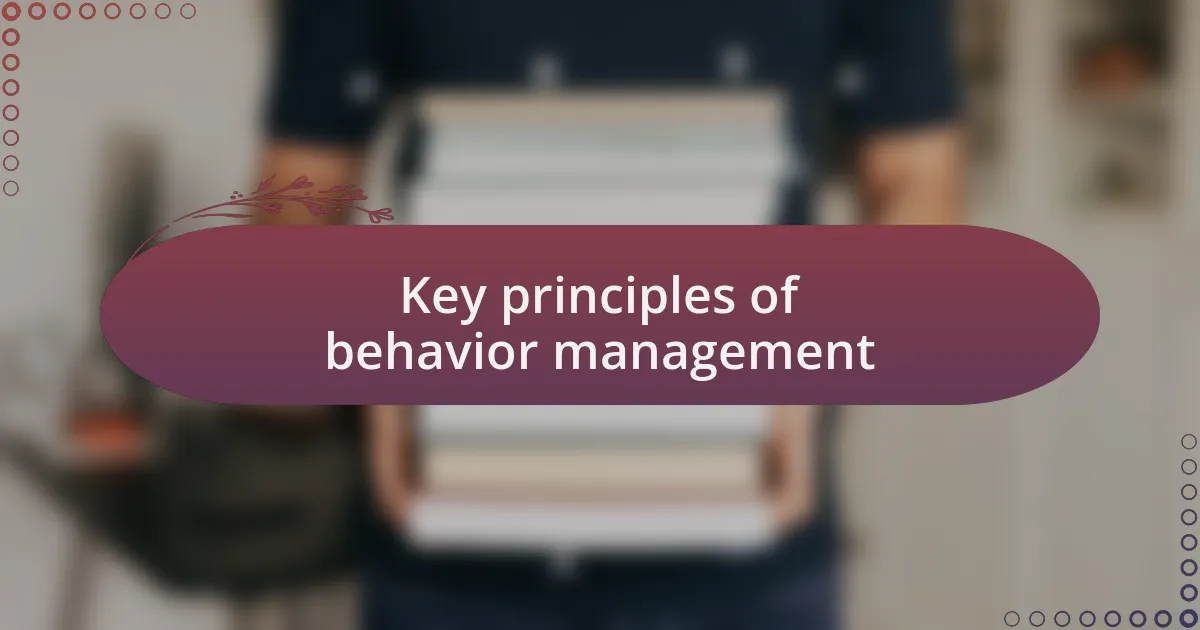
Key principles of behavior management
Effective behavior management relies heavily on clear expectations. I remember vividly the first day I laid out specific classroom rules with my students, using simple language and engaging visuals. Their eyes lit up as they contributed to shaping these guidelines. When students understand what is expected of them, the whole classroom dynamic changes. Don’t you find that when boundaries are clear, there’s less uncertainty and more cooperation?
Another cornerstone of behavior management is consistent reinforcement, both positive and negative. I once implemented a system where I celebrated small milestones instead of just waiting for big accomplishments. This made a significant impact on students’ motivation—one student even shared how much he looked forward to Fridays, knowing we would acknowledge everyone’s progress. Isn’t it amazing how small gestures can create a ripple effect of positive behavior?
Lastly, fostering relationships is essential for effective behavior management. I’ve found that when I take time to connect with my students individually, their engagement tends to soar. A simple check-in or a casual conversation can work wonders. Have you noticed how much more willing students are to adhere to expectations when they feel valued and understood? This emotional connection forms the backbone of a respectful learning environment, allowing everyone to thrive.
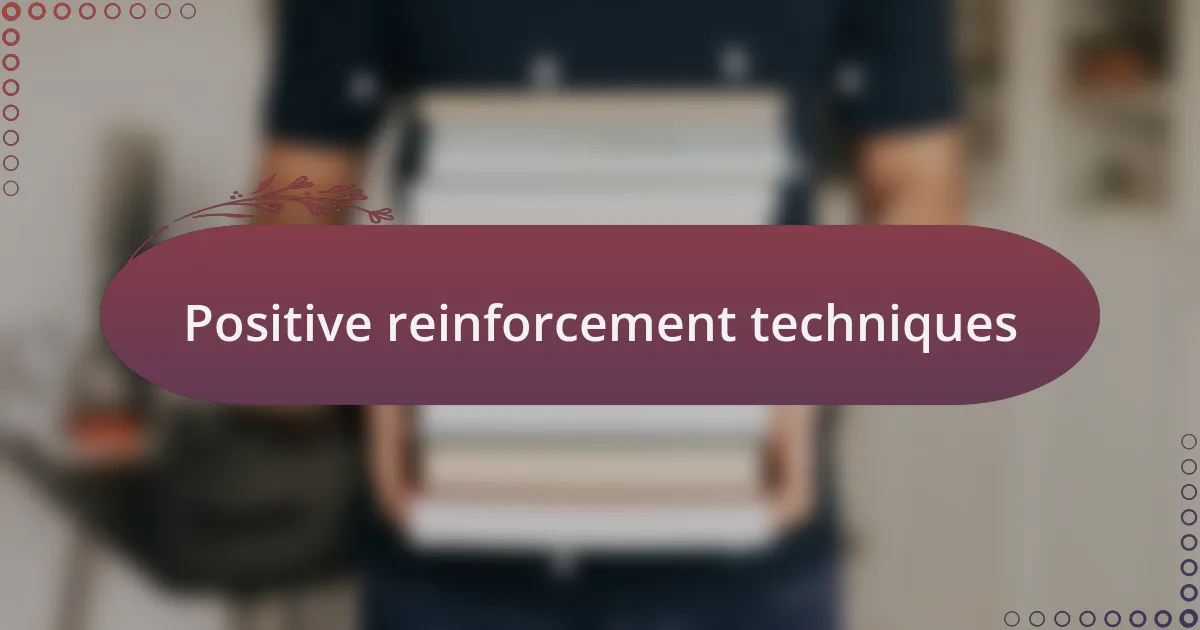
Positive reinforcement techniques
Positive reinforcement techniques are incredibly effective in shaping classroom behavior. For instance, I once introduced a reward system that involved earning tokens for positive actions, such as helping a classmate or contributing to discussions. Watching the students eagerly work towards their next reward filled me with joy. Have you ever observed how excitement builds when students know their efforts will be recognized?
One approach I particularly cherish is giving verbal praise. It’s amazing how a simple phrase like “Great job!” can transform a child’s demeanor. I remember a student named Mia, who had struggled with participation. When I made a point to celebrate her contributions, even if they were small, I saw her confidence blossom. Isn’t it remarkable how our words can empower students to reach even higher?
Another technique I found invaluable is incorporating fun challenges and competitions. I once organized a week-long reading challenge, rewarding the class that logged the most reading hours with a small party. The energy in the room shifted; students were motivated not just by the prize but by the shared goal. How often do we forget that learning can be incredibly fun when we tap into students’ competitive spirits?
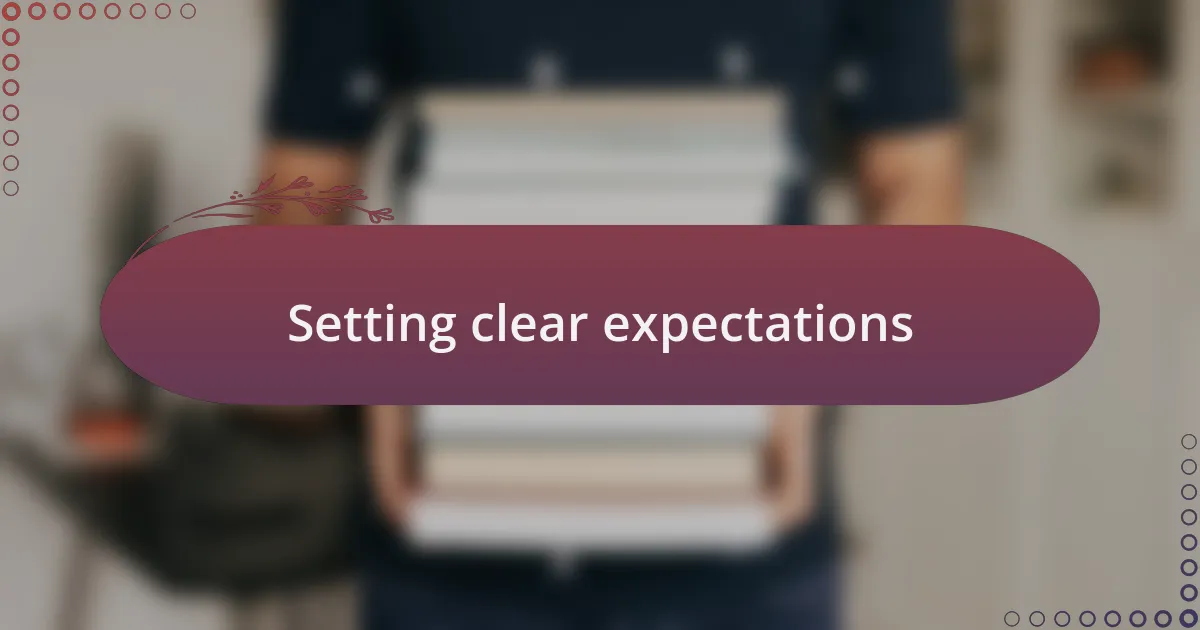
Setting clear expectations
Setting clear expectations is essential for fostering a positive classroom environment. When I began my teaching career, I realized that a lack of clarity often led to confusion and misbehavior. By spending the first few days of school outlining rules and procedures in simple, achievable terms, I noticed a significant shift in student behavior. Have you ever found that students are far more capable of meeting expectations when they know exactly what those expectations are?
I remember implementing a simple visual chart that displayed class rules alongside corresponding behaviors. Each rule was paired with a visual cue, making it easy for students to engage. One day, I overheard a student remind a classmate of the ‘respect’ rule by pointing to the chart, and it struck me how empowering that was. It highlighted not just their understanding of the rules but also their ownership in upholding them. How often do we overlook the power of clarity in guiding behavior?
In my experience, involving students in the creation of classroom rules can further solidify their commitment. One year, I facilitated a discussion where students contributed to the rule-making process. Their excitement in crafting guidelines led to a deeper respect for what we established together. Don’t we all appreciate ownership, especially when it comes to our learning environment?
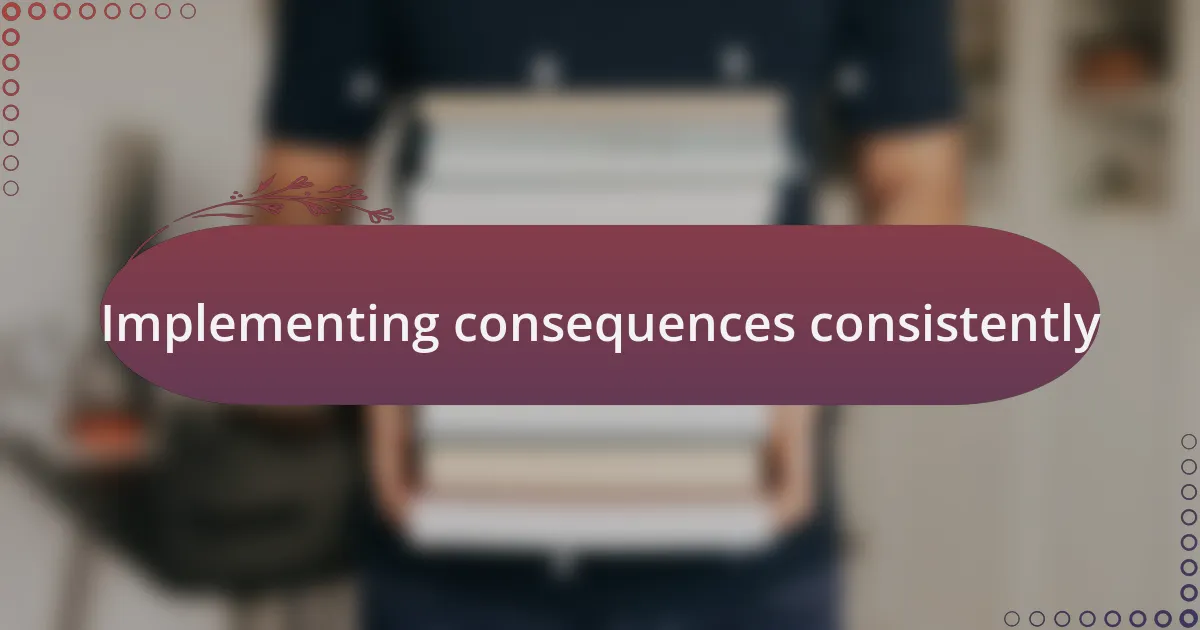
Implementing consequences consistently
Consistently implementing consequences is crucial for reinforcing the expectations we set in the classroom. I learned this lesson the hard way during my second year of teaching when I momentarily let some disruptive behaviors slide. I noticed that my students quickly picked up on my inconsistency, and what started as a minor issue turned into a classroom culture riddled with disregard for rules. Have you ever experienced a similar shift when boundaries aren’t enforced?
One strategy I’ve found effective is to communicate consequences beforehand and ensure students understand the process. When a student breaks a rule, I calmly remind them of the established consequence, creating a moment for reflection rather than reacting in anger. I recall a time when I had to follow through with this after a student repeatedly interrupted. Instead of feeling frustrated, I used the opportunity to reinforce the importance of respect for others, which led to a more reflective environment. How often do we take the time to turn a disciplinary moment into a teaching one?
I even create a consequence chart that visually tracks behavior for the class. This transparency fosters a sense of fairness among students. In fact, I recall a moment when a student approached me after class to express gratitude for the clarity in our disciplinary system. They said it made them feel safe in knowing what to expect. Doesn’t it make sense that when students feel secure about the consequences, they are more likely to respect the rules?
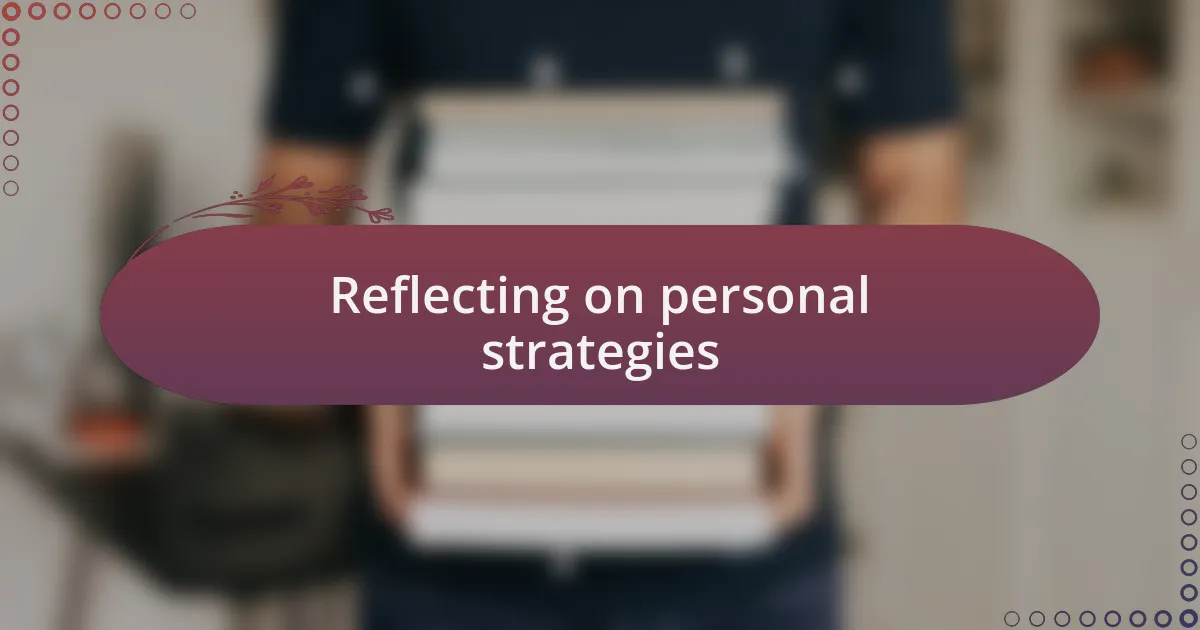
Reflecting on personal strategies
Reflecting on my personal strategies has been a journey of trial and error. Early on, I realized that simply outlining rules wasn’t enough; I needed to be genuine in my interactions with students. There was a day when I noticed a student struggling to stay engaged and was acting out during lessons. Instead of reprimanding them immediately, I approached them afterwards to discuss their feelings. It turned out they were feeling overwhelmed and disconnected from the material. Isn’t it interesting how sometimes, just pausing to listen can change everything?
Another tactic I’ve adopted is to encourage students to participate in setting some of the classroom norms. This not only empowers them but also fosters accountability. I remember a day when my class collectively agreed to “lighten up” when it came to mistakes, and it transformed our atmosphere. Students began sharing their slip-ups without fear, leading to a supportive environment where we all learned from each other. Have you found that giving students a voice in the rules enhances their acceptance of those boundaries?
Moreover, I find that reflection sessions at the end of each week help me recalibrate my approach. One time, after a particularly challenging week, I gathered the class for a sharing circle. I asked them what strategies had worked and what hadn’t. To my surprise, their insights not only improved my management techniques but also strengthened our bond. Doesn’t it stand out how collaboration can be a crucial part of personal growth in teaching?